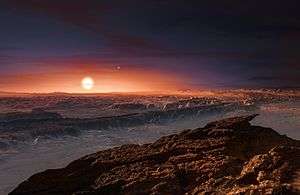BOSS Great Wall
The BOSS Great Wall is a galaxy wall, a subtype of galaxy filaments, that was discovered early 2016. It is one of the largest superstructures in the observable universe.[1][note 1] It contains perhaps 10 000 times the mass of the Milky Way. It is 1 billion light years across, and contains 830 visible galaxies, as well as many others that are invisible (dark galaxies). It contains five times the density compared to the standard cosmological density of the universe. Its redshift is about z=0.47 (z times Hubble length ≈ 6800 million light years).[1][2]
It was discovered using the Baryon Oscillation Spectroscopic Survey (BOSS) of the Sloan Digital Sky Survey, hence its name, by H. Lietzen, E. Tempel, L. J. Liivamägi, A. Montero-Dorta, M. Einasto, A. Streblyanska, C. Maraston, J. A. Rubiño-Martín and E. Saar.
Notes
- ↑ Statements by the popular press incorrectly described the BOSS Great Wall as the largest structure in the universe; but the similar Hercules-Corona Borealis Great Wall is about ten times larger.
References
- 1 2 "Billion-light year galactic wall may be largest object in cosmos". New Scientist. Mar 12, 2016.
- ↑ Lietzen, H.; Tempel, E.; Liivamägi, L. J.; Montero-Dorta, A.; Einasto, M.; Streblyanska, A.; Maraston, C.; Rubiño-Martín, J. A.; Saar, E. (February 2016). "Discovery of a massive supercluster system at z∼0.48". Astronomy & Astrophysics (published April 2016). 588. arXiv:1602.08498
 . Bibcode:2016A&A...588L...4L. doi:10.1051/0004-6361/201628261. L4.
. Bibcode:2016A&A...588L...4L. doi:10.1051/0004-6361/201628261. L4.

.jpg)
